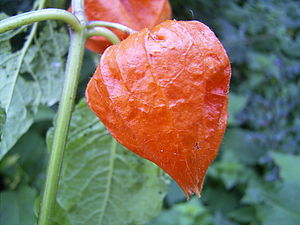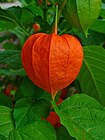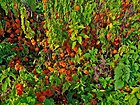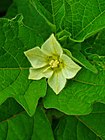Note: This is a project under development. The articles on this wiki are just being initiated and broadly incomplete. You can Help creating new pages.
Difference between revisions of "Physalis alkekengi - Bladder cherry"
(→References) |
(→List of Ayurvedic medicine in which the herb is used) |
||
| Line 47: | Line 47: | ||
==List of Ayurvedic medicine in which the herb is used== | ==List of Ayurvedic medicine in which the herb is used== | ||
| − | |||
==Where to get the saplings== | ==Where to get the saplings== | ||
Revision as of 17:01, 11 June 2019
Physalis alkekengi (bladder cherry, Chinese lantern, Japanese-lantern, strawberry groundcherry, or winter cherry) is a relative of P. peruviana (Cape gooseberry). It is easily identifiable by the large, bright orange to red papery covering over its fruit, which resembles paper lanterns.
Contents
- 1 Uses
- 2 Parts Used
- 3 Chemical Composition
- 4 Common names
- 5 Properties
- 6 Habit
- 7 Identification
- 8 List of Ayurvedic medicine in which the herb is used
- 9 Where to get the saplings
- 10 Mode of Propagation
- 11 How to plant/cultivate
- 12 Commonly seen growing in areas
- 13 Photo Gallery
- 14 References
- 15 External Links
Uses
abortion, gravel, malaise, malaria, skin inflammations, kidney, bladder disorders, Common Cold, gout.
Parts Used
Chemical Composition
Like a number of other species in the genus Physalis, it contains a wide variety of physalins. When isolated from the plant, these have antibacterial and leishmanicidal activities in vitro.It also contains caffeic acid ethyl ester, dehydro-physalin L, physalin D, and cuneataside E[1]
Common names
| Language | Common name |
|---|---|
| Kannada | |
| Hindi | Akarkara |
| Malayalam | Akkarakaaram |
| Tamil | |
| Telugu | |
| Marathi | NA |
| Gujarathi | NA |
| Punjabi | NA |
| Kashmiri | NA |
| Sanskrit | Akarkarabh |
| English | Pellitory |
Properties
Reference: Dravya - Substance, Rasa - Taste, Guna - Qualities, Veerya - Potency, Vipaka - Post-digesion effect, Karma - Pharmacological activity, Prabhava - Therepeutics.
Dravya
Rasa
Guna
Veerya
Vipaka
Karma
Prabhava
Habit
Identification
Leaf
| Kind | Shape | Feature |
|---|---|---|
| Smooth | Alternate, Pinnate | Alternate or opposite, stalked. Leaf blade widely ovate, usually blunt-based, with entire margins–sparsely large-toothed, sparsely short-haired |
Flower
| Type | Size | Color and composition | Stamen | More information |
|---|---|---|---|---|
| Unisexual | 15–20 mm (0.6–0.8 in.) wide | yellowish white | Stamens 5 | Regular (actinomorphic), fused, wheel-shaped, 5-lobed, underside hairy. Calyx fused, 5-lobed, initially campanulate, green; spreading, concealing berries after flowering, eventually 25–50 mm (1–2 in.) long, oval, yellowish red, anthers tight against corolla tube |
Fruit
| Type | Size | Mass | Appearance | Seeds | More information |
|---|---|---|---|---|---|
| spherical | 15 mm (0.6 in.) long berry | Fruiting time: July–August | seeds many, ovoid. | {{{6}}} |
Other features
List of Ayurvedic medicine in which the herb is used
Where to get the saplings
Mode of Propagation
How to plant/cultivate
Seed - sow March/April in a greenhouse only just covering the seed. Germination usually takes place quickly and freely. [3]
Commonly seen growing in areas
wasteland, gardens, Ornamental.
Photo Gallery
References
External Links
- Ayurvedic Herbs known to be helpful to treat abortion
- Ayurvedic Herbs known to be helpful to treat gravel
- Ayurvedic Herbs known to be helpful to treat malaise
- Ayurvedic Herbs known to be helpful to treat malaria
- Ayurvedic Herbs known to be helpful to treat skin inflammations
- Ayurvedic Herbs known to be helpful to treat kidney
- Ayurvedic Herbs known to be helpful to treat bladder disorders
- Ayurvedic Herbs known to be helpful to treat Common Cold
- Ayurvedic Herbs known to be helpful to treat gout
- Herbs with Roots used in medicine
- Herbs with Leaves used in medicine
- Herbs with Fruits used in medicine
- Herbs with common name in Hindi
- Herbs with common name in Malayalam
- Herbs with common name in Sanskrit
- Herbs with common name in English
- Habit - Perennial herb
- Index of Plants which can be propagated by Seeds
- Index of Plants which can be propagated by Cuttings
- Herbs that are commonly seen in the region of wasteland
- Herbs that are commonly seen in the region of gardens
- Herbs that are commonly seen in the region of Ornamental
- Herbs
- Solanaceae







